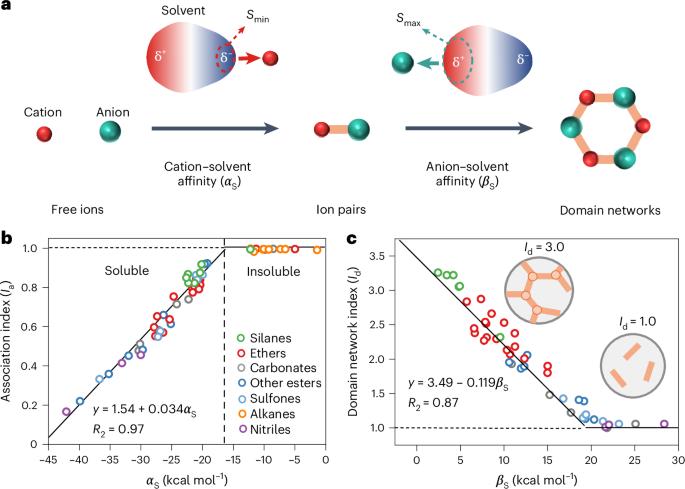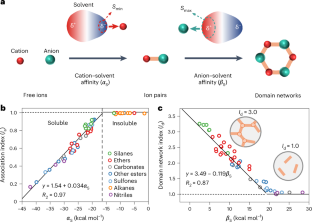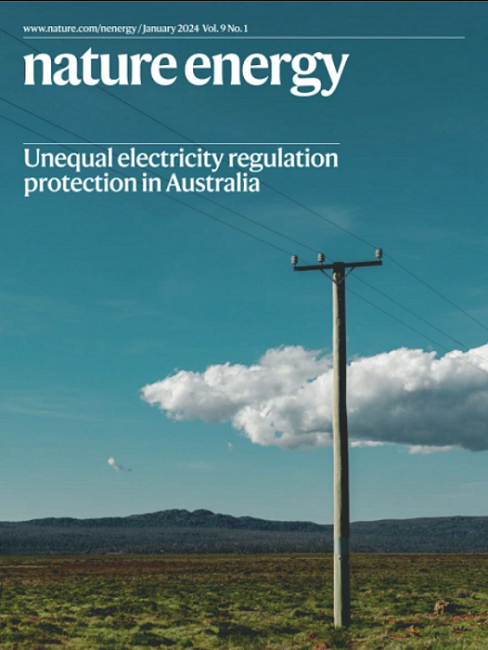Unified affinity paradigm for the rational design of high-efficiency lithium metal electrolytes
IF 60.1
1区 材料科学
Q1 ENERGY & FUELS
引用次数: 0
Abstract
Electrolyte engineering breakthroughs are crucial to support extremely high-energy battery chemistries. However, the complex interplay between battery performance and electrolyte structure remains poorly understood and difficult to predict. Here we introduce the concept of ‘normalized cation/anion–solvent affinity’, which describes the critical interactions between solvents and both cations and anions. This innovative approach allows for the simultaneous and quantitative prediction of electrolyte microstructures, transport characteristics, redox behaviours and interphase characteristics. Leveraging this framework, we screened approximately 150 solvent candidates and identified electrolyte formulations that significantly improve Li metal plating/stripping Coulombic efficiency ( >99.5%). Among these, four electrolytes achieved Coulombic efficiency greater than 99.8%, while supporting the durability of aggressive high-voltage cathodes. These formulations enabled the realization of highly reversible Li metal batteries (LMBs) with a record-breaking high energy density of 600 Wh kg−1 and over 100 cycles, advancing LMBs towards practical applications. The unified affinity paradigm offers valuable insights for designing next-generation electrolytes for high-energy LMBs and other alkali-metal-ion batteries. Electrolyte design is key for high-energy lithium metal batteries, but structure–performance links are hard to predict. A framework using the normalized cation/anion–solvent affinity enables quantitative prediction of microstructure, transport and interphase, driving exceptional performance.


高效锂金属电解质合理设计的统一亲和范式
电解质工程的突破对于支持高能量电池化学至关重要。然而,电池性能和电解质结构之间复杂的相互作用仍然知之甚少,难以预测。在这里,我们引入了“正规格化阳离子/阴离子-溶剂亲和”的概念,它描述了溶剂与阳离子和阴离子之间的关键相互作用。这种创新的方法允许同时和定量预测电解质的微观结构、传输特性、氧化还原行为和间相特性。利用这一框架,我们筛选了大约150种候选溶剂,并确定了显著提高锂金属电镀/剥离库仑效率(99.5%)的电解质配方。其中,四种电解质的库仑效率超过99.8%,同时支持侵略性高压阴极的耐用性。这些配方使高度可逆的锂金属电池(lmb)成为可能,其能量密度达到创纪录的600 Wh kg - 1,循环次数超过100次,推动了lmb的实际应用。统一亲和模式为设计高能lmb和其他碱金属离子电池的下一代电解质提供了有价值的见解。
本文章由计算机程序翻译,如有差异,请以英文原文为准。
求助全文
约1分钟内获得全文
求助全文
来源期刊

Nature Energy
Energy-Energy Engineering and Power Technology
CiteScore
75.10
自引率
1.10%
发文量
193
期刊介绍:
Nature Energy is a monthly, online-only journal committed to showcasing the most impactful research on energy, covering everything from its generation and distribution to the societal implications of energy technologies and policies.
With a focus on exploring all facets of the ongoing energy discourse, Nature Energy delves into topics such as energy generation, storage, distribution, management, and the societal impacts of energy technologies and policies. Emphasizing studies that push the boundaries of knowledge and contribute to the development of next-generation solutions, the journal serves as a platform for the exchange of ideas among stakeholders at the forefront of the energy sector.
Maintaining the hallmark standards of the Nature brand, Nature Energy boasts a dedicated team of professional editors, a rigorous peer-review process, meticulous copy-editing and production, rapid publication times, and editorial independence.
In addition to original research articles, Nature Energy also publishes a range of content types, including Comments, Perspectives, Reviews, News & Views, Features, and Correspondence, covering a diverse array of disciplines relevant to the field of energy.
 求助内容:
求助内容: 应助结果提醒方式:
应助结果提醒方式:


